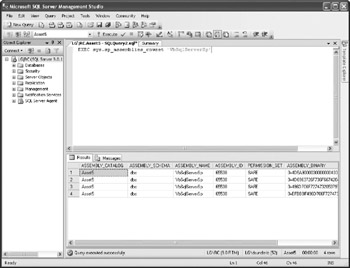Cataloging Assemblies and CLR Database Objects
An important part of the management of assemblies and CLR database objects is to be able to find out what is installed on the database—and what is not.
Cataloging Assemblies
The place to start is the sys.assemblies catalog view that contains information about the assembly names, identifiers, permissions, and visibility.
SELECT * FROM sys.assemblies
The result of the query will be something like Table 11-1.
| Name | principal id | assembly_id | clr_name | permission_set | permission_set_dcsc | is_visible | create_date | modify_date |
|---|---|---|---|---|---|---|---|---|
| VbSqlServerSp | 1 | 65538 | vbsqlserversp, | 1 | SAFE_ACCESS | 1 | 2005-10-30 | 2005-10-30 |
| CShrpSqlServerSp | 1 | 65540 | cshrpsqlserversp, | 1 | SAFE_ACCESS | 1 | 2005-10-30 | 2005-10-30 |
There is a system stored procedure that provides access to this and other related tables. The sys.sp_assemblies_rowset procedure returns information about the assembly along with its binary. Figure 11-6 shows the result. The result may contain multiple rows for each file that is larger than 8,000 bytes.

Figure 11-6: Rowset of assemblies
Cataloging Procedures
You have probably noticed that I sometimes use the word procedure in a broader context—to reference all types of programmable database objects (such as stored procedures, functions, and triggers). Some parts of BOL refer to them as modules. I think that both BOL and I should have chosen different terms. In the software development books that I learned from, modules were larger sets of programmable objects (such as C# classes as sets of methods and properties, C libraries as sets of functions, and Visual Basic 6 modules as files that contain subroutines and functions). On the other hand, the distinction between procedure and stored procedure is too subtle.
In SQL Server 2005, you can query for modules (programmable database objects) and assembly modules (CLR database objects):
SELECT * FROM sys.assembly_modules
An example of a result is shown in Table 11-2.
| object_id | assembly_id | assembly_class | assembly_method | null_on_null_input | execute_as_principal_id |
|---|---|---|---|---|---|
| 1086626914 | 65538 | VbSqIServerSp.StoredProcedures | ap_FirstVB | 0 | NULL |
| 1118627028 | 65540 | StoredProcedures | ap_First | 0 | NULL |
To read metadata that is collected in a database about a database object, such as a stored procedure, you can use the following query:
SELECT schema_name(sp.schema_id) + '.' + sp.[name] AS [Name] , sp.create_date , sp.modify_date , sa.permission_set_dcsc AS [Access] , sp.is_auto_executed FROM sys.procedures AS sp INNER JOIN sys.module_assembly_usages AS sau ON sp.object_id = sau.object_id INNER JOIN sys.assemblies AS sa ON sau.assembly_id = sa.assembly_id WHERE sp.type_dcsc = N'CLR_STORED_PROCEDURE'
Version of .NET Framework
You can find out which version of CLR is loaded in SQL Server by querying the version of the Microsoft .NET Runtime Execution Engine module:
SELECT mdl.product_version FROM sys.dm_os_loaded_modules AS mdl WHERE mdl.[name] LIKE N'%\MSCOREE.DLL'
EAN: 2147483647
Pages: 165